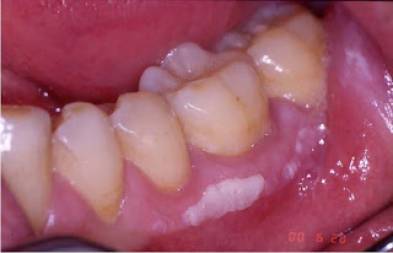Erythroplakia affects both men and women, but it is more common in individuals over 50 years of age.
Erythroplakia significance and risk factors
The diagnosis of erythroplakia is critical because it has a higher malignant transformation rate when compared to other leukoplakic lesions. Therefore, early identification and intervention are essential. The risk factors for erythroplakia include tobacco and alcohol consumption, poor dental hygiene, and chronic irritation of the mouth or throat. Other risk factors may include poor nutrition, poor immune function, and exposure to certain chemicals and toxins.
Individuals with erythroplakia are recommended to undergo biopsy and histological examination to determine the extent of the lesion and the potential for malignant transformation. Treatment options may include surgery or radiation therapy depending on the severity and stage of the lesion. Regular follow-up and preventive measures are crucial to monitor the condition and prevent the recurrence of the lesion.
Causes of Erythroplakia
Tobacco and alcohol use
The primary cause of erythroplakia is tobacco and alcohol use. The carcinogens present in tobacco smoke and alcoholic beverages can irritate the mucosal lining of the mouth and throat, leading to cellular changes that promote cancer development. Individuals who use tobacco and alcohol are at a higher risk of developing erythroplakia.
HPV infection and other risk factors
In addition to tobacco and alcohol use, other risk factors may include infection with the Human Papilloma Virus (HPV), poor oral hygiene, malnutrition, and chronic irritation of the mouth or throat. Exposure to certain chemicals and toxins may also increase the risk of developing erythroplakia. Individuals who are immunocompromised may also be at higher risk for the disease.
Early detection and treatment are crucial for erythroplakia. Individuals at risk should seek regular dental and medical exams to identify and treat any potential lesions before they progress to cancer. Quitting tobacco and alcohol use and maintaining good oral hygiene may also reduce the risk of developing erythroplakia.
Symptoms of Erythroplakia
Painless red patches in the mouth
Individuals with erythroplakia may notice painless red patches in their mouth or throat. These patches may be velvety or granular in appearance, and they may bleed easily when scraped or touched. These patches are a warning sign and should be examined by a healthcare professional immediately.
Difficulty chewing and swallowing
As erythroplakia progresses, individuals may experience difficulty chewing and swallowing. This is a result of the lesions and patches interfering with normal oral function. If left untreated, erythroplakia can progress to oral cancer, which can cause significant pain, disfigurement, and even death!
It is essential for individuals to seek medical attention if they experience any of these symptoms. Early detection and treatment can help prevent the progression of erythroplakia to oral cancer. A healthcare professional can perform a thorough evaluation and provide appropriate treatment options.
Diagnosis of Erythroplakia
Physical examination and biopsy
Diagnosing erythroplakia involves a thorough physical examination of the oral cavity and biopsy of any suspicious lesions or patches. During the examination, the healthcare professional looks for red or white patches, ulcers, or lumps. They may use a special light that can detect abnormal cells in the mouth, called a chemiluminescence device.
A biopsy involves removing a small piece of tissue from the lesion or patch and examining it under a microscope. This helps to determine whether the cells are cancerous or not. A biopsy is the only way to make a definitive diagnosis of erythroplakia.
Imaging tests and laboratory tests
Imaging tests, such as X-rays, CT scans, and MRI scans, may be performed to determine the extent of the disease and whether it has spread beyond the mouth. Laboratory tests may also be done to check for abnormal cells or genetic markers that can indicate cancer.
It is important for individuals to undergo these diagnostic tests if they are experiencing symptoms of erythroplakia. Early detection and treatment can significantly improve the chances of a successful outcome.
Treatment for Erythroplakia
Surgery and laser therapy
The main treatment for erythroplakia is surgical removal of the lesion or affected area. This can be done using traditional surgery or laser therapy, depending on the extent and severity of the disease. In some cases, the healthcare professional may need to remove surrounding tissues to ensure that all the cancerous cells have been removed.
Radiation therapy and chemotherapy
Radiation therapy and chemotherapy may be recommended in addition to surgery for advanced cases of erythroplakia. Radiation therapy uses high-energy X-rays to kill cancer cells, while chemotherapy uses drugs to kill cancer cells. Both treatments can have side effects, including fatigue, nausea, and hair loss.
It is important to work closely with a healthcare professional to determine the best treatment plan for each individual case of erythroplakia. Regular follow-up appointments and surveillance are also important to monitor for recurrence or the development of new lesions.
Prevention of Erythroplakia
Healthy lifestyle choices
The best way to prevent erythroplakia is to make healthy lifestyle choices. It is recommended to quit smoking and avoid all tobacco products. Individuals should also limit alcohol consumption as heavy drinking can increase the risk of developing oral cancer. A well-balanced diet rich in fruits and vegetables, as well as regular exercise, can also help to reduce the risk of developing erythroplakia.
Regular dental checkups and cancer screenings
Individuals should schedule regular dental checkups with their healthcare professional. During these visits, the healthcare professional can examine the mouth for any signs of erythroplakia or other oral cancers. The healthcare professional may also recommend regular cancer screenings for those who are at high risk of developing oral cancer. Early detection and treatment can significantly improve the prognosis and outcome of erythroplakia.
Importance of Early Detection
Red flags for Erythroplakia
Erythroplakia is a condition that affects the soft tissues of the mouth, including the gums and tongue. Common symptoms include red, velvety patches that may be painful or bleed easily. Individuals who experience these symptoms, or who notice any changes in the mouth or throat, should seek medical attention immediately.
Self-examinations and seeking medical attention
Regular self-examinations can also help to detect erythroplakia and other oral cancers early on. Individuals should regularly inspect their mouth, tongue, and gums for any signs of abnormality. If any changes are noticed, it is crucial to seek medical attention as soon as possible. Healthcare professionals can perform a thorough examination and recommend appropriate diagnostic tests and treatments if necessary. Early detection and treatment can significantly improve the prognosis and outcome of erythroplakia. Therefore, it is essential to take preventive measures, seek regular check-ups, and report any changes or abnormalities promptly to a healthcare professional.
Living with Erythroplakia
Coping strategies and emotional support
Living with erythroplakia can be challenging, both physically and emotionally. Coping strategies and emotional support play a vital role in managing the condition. Individuals diagnosed with erythroplakia may benefit from joining support groups, where they can connect with others who share similar experiences and receive empathy, advice, and encouragement.
Counseling and therapy can also be beneficial to individuals living with erythroplakia. Therapy can help individuals manage symptoms related to depression, anxiety, and stress, which are often associated with chronic health conditions. Building a strong support system with family and friends can also provide emotional support and help individuals cope with the challenges of living with erythroplakia.
Nutrition and oral hygiene recommendations
A healthy diet combined with proper oral hygiene can help improve overall health and reduce the risk of developing complications related to erythroplakia. Individuals diagnosed with erythroplakia should aim to eat a balanced diet rich in fruits, vegetables, and whole grains.
Maintaining good oral hygiene is also essential to managing the condition. This includes brushing teeth twice a day with a soft-bristled toothbrush and flossing nightly. Regular dental check-ups should also be part of the oral hygiene routine to ensure that any dental issues are detected and treated promptly.
In conclusion, living with erythroplakia requires a comprehensive approach that includes both physical and emotional management. By adopting healthy lifestyle practices, seeking emotional support, and receiving proper medical care, individuals living with erythroplakia can improve their quality of life and manage the condition more effectively.
Conclusion
Erythroplakia overview and key takeaways
Living with erythroplakia can be challenging, but there are coping strategies, emotional support, and lifestyle changes that can help manage the condition. Joining support groups, counseling or therapy, building a strong support system with family and friends, maintaining a healthy diet, and proper oral hygiene are essential for individuals with erythroplakia.
Key takeaways from this article include the importance of early detection, regular dental check-ups, and the need for an integrated approach that addresses both physical and emotional aspects of the condition.
Ongoing research
Ongoing research and advancements in medical and dental technology offer hope for the future of erythroplakia. Early detection and prevention strategies, new treatment options, and a better understanding of the condition’s causes and risk factors are all essential for improving patient outcomes.
By continuing to raise awareness and invest in research on erythroplakia, medical professionals and researchers are working to improve the lives and outcomes of individuals living with this condition.






